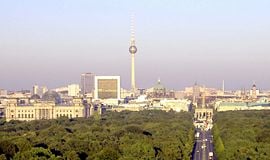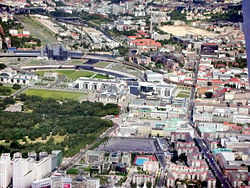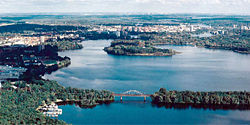Berlin
| Berlin | |||

| |||
| Flag | Coat of arms | ||
| |||
| Location of Berlin within Germany / EU | |||
| Location of Berlin within Germany / EU | |||
| Coordinates | Template:Coord/display/title,inline | ||
| Time zone | CET/CEST (UTC+1/+2) | ||
| Administration | |||
| Country | Germany | ||
| NUTS Region | DE3 | ||
| City subdivisions | 12 boroughs | ||
| Governing Mayor | Klaus Wowereit (SPD) | ||
| Governing parties | SPD / Left | ||
| Votes in Bundesrat | 4 (from 69) | ||
| Basic statistics | |||
| Area | 892 km² (344 sq mi) | ||
| - Elevation | 34 - 115 m | ||
| Population | 3,405,000 (11/2006)[1][2] | ||
| - Density | 3,818 /km² (9,889 /sq mi) | ||
| - Urban | 3,700,000 | ||
| - Metro | 4,262,480 (12/2004) | ||
| Other information | |||
| GDP/ Nominal | € 80.3 billion (2006) | ||
| Postal codes | 10001–14199 | ||
| Area codes | 030 | ||
| Licence plate code | B | ||
| Website | berlin.de / 3D Berlin | ||
Berlin is the capital city and one of the 16 states of the Federal Republic of Germany. Located in northeastern Germany, it is the center of the Berlin-Brandenburg metropolitan area, comprising 4.9 million people from over 180 nations.
Berlin was successively the capital of the Kingdom of Prussia (1701-1918), the German Empire (1871-1918), the Weimar Republic (1919-1933) and the Third Reich (1933-1945). After World War II, the city was divided; East Berlin became the capital of East Germany while West Berlin became a Western enclave, surrounded by the Berlin Wall from 1961-1989. Following the reunification of Germany in 1990, the city regained its status as the capital of all Germany.
Berlin is a center in European politics, culture, media, and science. The metropolis is home to world-renowned universities, research institutes, sporting events, orchestras, museums and personalities. Recognized for its festivals, contemporary architecture, nightlife and avant-garde arts, Berlin has evolved into a focal point for individuals attracted by liberal lifestyle, and modern zeitgeist (“the spirit of the times”).
Geography
The name Berlin may derive from the old (West Slavic) Polabian stem berl- or birl- meaning "swamp".
Berlin is located in eastern Germany, about 44 miles (70km) west of the border with Poland in an area with marshy terrain. Berlin's landscape was shaped by ice sheets during the last Ice Age. The city center lies along the river Spree in the Berlin-Warsaw Urstromtal (ancient river valley), formed by water flowing from melting ice sheets.
Substantial parts of present-day Berlin extend onto the low plateaus on both sides of the Spree Valley. Large parts of the boroughs Reinickendorf and Pankow lie on the Barnim plateau, while most of the boroughs Charlottenburg-Wilmersdorf, Steglitz-Zehlendorf, Tempelhof-Schöneberg, and Neukölln lie on the Teltow plateau. The borough of Spandau lies partly within the Berlin Urstromtal and pa
- ↑ Portal of the Federal Statistics Office Germany. State population Retrieved July 31, 2008.
- ↑ Eurostat. Indicators for larger urban zones 1999 - 2003 Retrieved July 31, 2008.



